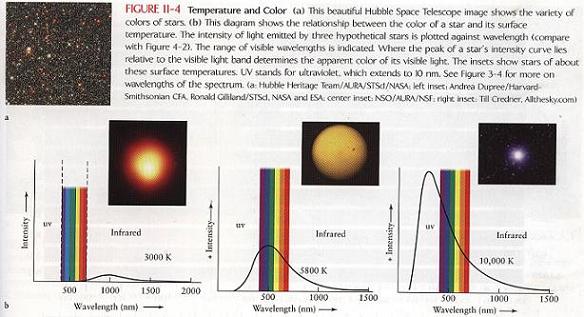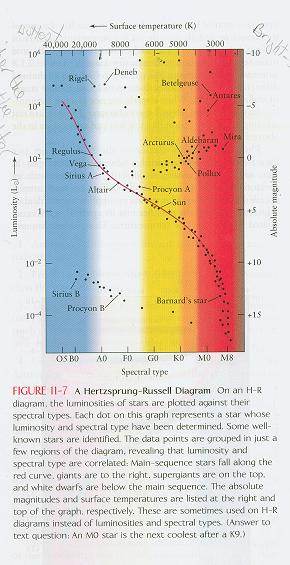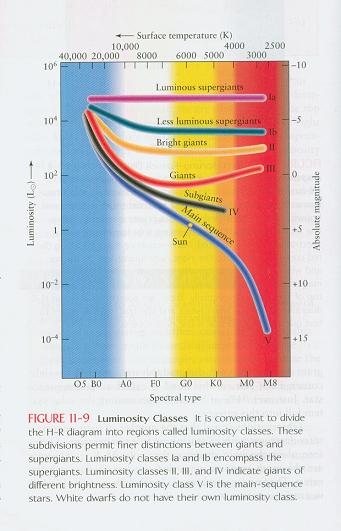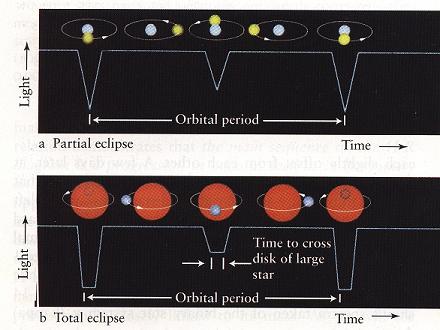CHAPTER 11 STUDY GUIDE
How far away in kilometers and miles and light years is the nearest star besides the sun? When do Kansas Citians see this star? What is it called?
The nearest star is Proxima Centauri. It is about 40 trillion km, or 25 trillion miles, or 4 light-years away.
Kansas Citians would see it in the constellation Centaurus which is not visible to us.
Stellar parallax is defined as motion of nearby stars against background stars. How do scientists measure it? Draw pictures of positions of stars and scientists (earth) to describe how it is done. A measure of 1/3 arc second is how many parsecs? 1/50 arc second is how many parsecs?
Scientists measure stellar parallax by the equation d=1/p where d is the distance to the star in parsecs and p is the parallax angle of the star in arc seconds.
A distance of 1/3 arc seconds is equal to 3 parsecs.
A distance of 1/50 arc seconds is equal to 50 parsecs.
Apparent magnitude and absolute magnitude are measures of brightness of stars. What is the difference between them? What is the visible range of stars on each?
Apparent magnitude is how bright a star appears in our night sky. It has a range of +30 to -26.7
Absolute magnitude is how bright a star is at 10 parsecs. It has a range of -10 to +17
How does the inverse square law work? How does the brightness and area compare for a distance of 1 to a distance of 4?
The inverse square law states that the further away from the source a beam of light gets, the more area it covers and the dimmer it gets.
At a distance of 1, the brightness is 1 and the area covered is 1.
At a distance of 4, the brightness is 1/16 and the area covered is 16.
In the Astronomerís Toolbox at the top of page 298, how does the brightness of a magnitude 1 star compare with a magnitude 6 star? By what multiplication factor does each successive number change?
The brightness of a magnitude 1 star is 100 times greater than a magnitude 6 star. Each successively brighter star is 2.512 times brighter than the preceeding magnitude.
Define luminosity.
The total amount of electromagnetic energy emitted each second
Without worrying about calculating what does the formula M=m-5log(d/10) do?
It converts the apparent magnitude(m) of a star into the absolute magnitude(M) as long as the distance(d) to the star is known.
What two things does the peak of a blackbody radiation curve tell us?
The emitted spectrum of the blackbody and its temperature.
Will a star appear bright or dim when viewed through a blue filter if its peak radiation is in the infrared? Will a star appear bright or dim when viewed through a blue filter if its temperature is 8,000 K? Extend your understanding of this to IR, red, yellow, blue, and UV filters with stars of different temperatures. How does wavelength compare with temperature?
An infrared star will appear dim through a blue filter.
An 8000K star will appear bright through a blue filter.
Wavelength compared to temperature in that the higher that temperature the shorter that wavelength.

The strength of spectroscopic absorption lines depends on a starís __________. At what stellar temperature are hydrogen Balmer series lines strongest? At 25,000 K what is a good element to look for? At what temperature does neutral iron (Fe I) have strong spectral lines?
The strength depends on its temperature.
Hydrogen Balmer lines are strongest at 10,000 K.
Helium is good to look for at 25,000 K.
Neutral Iron (Fe I) has strong lines around 3500 K.

OBAFGKM is a classification of stars by what means?
It classifies stars by their surface temperature where O is the hottest at 30,000 to 50,000 K and M is the coolest at 2500 to 3000 K.

How are metals defined in astronomy (see bottom of page 303)?
Metals are all other elements besides hydrogen and helium.
Sketch a Hertzsprung-Russell diagram using a whole page of paper. Include spectral type, luminosity, absolute magnitude, and surface temperature on the axes being careful to correctly label the direction of increasing values. On the graph itself draw a line for the main sequence and note where the sun lies. In addition draw in a line for the luminosity classes Ia, Ib, II, III, IV, and V. Which one of these had you already drawn? Describe what types of stars are in each class. Now draw in diagonal constant radius lines as done on the top of page 306. What type of star is an A0 II? An F3 Ib? Using the diagram on page 304, what spectral type and luminosity class is Rigel? Aldebaron? Pollux?



What is spectroscopic parallax? If it has a larger error margin than stellar parallax, then why use it at all?
It is a method of determining a star's distance using the spectral type and luminosity class of the star.
It is used because it can determine stars at much greater distances than stellar parallax.
What percentage of stars near our solar system are binary stars? How are optical doubles different than true binaries? Where is the center of mass of a binary system located? What information can binary systems tell us?
66% of the nearby stars are binary.
Optical doubles aer stars that appear to be close together but are not, they simply lie in the same direction.
The center of mass is the common point that both stars orbit around. It is usually closer to the bigger star.
Binary systems can tell us the individual masses of the stars and the relationship of mass and luminosity.
How does mass relate to luminosity?
For main-sequence stars, the more massive a star is, the more luminous it is.
If a binary produces a single line spectra and then a double line spectra alternately, what information does that tell us? In comparing two binary systems, what does a larger separation in the double line spectra indicate?
This spectral behavior tells us that the stars are orbiting each other alternately moving away from us, parallel to us, and away from us.
A larger separation in the lines means a larger orbit for the stars.

What do light curves for partial eclipsing and total eclipsing binaries look like? What information can be possible to gain from eclipsing binaries?

The information that can be gained from eclipsing binaries are masses, diameters, brightnesses, speeds, stellar separations, and stellar atmospheres.







